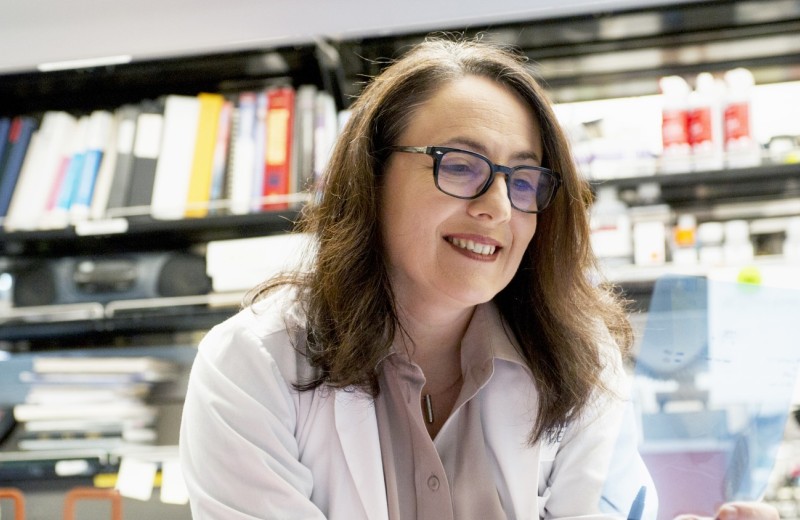Gladstone NOW: The Campaign Join Us on the Journey✕

For World Alzheimer’s Month, researchers talk about their work and hopes of finding new treatments for this debilitating disease
As a way to highlight World Alzheimer’s Month this September, six researchers at Gladstone talk about their work and how it can help us better understand the disease. They also discuss some of the biggest challenges on the horizon, and share how research can eventually lead to better treatments for Alzheimer’s disease.

Maxine Nelson
Graduate Student, Huang Lab
I study the effects of a particular protein related to Alzheimer’s disease: apoE. A certain version of this protein can significantly increase your odds of developing the disease. In the lab, I use CRISPR-Cas9 technology to create disease-related mutations in human stem cells grown in culture dishes. Then, I turn these cells into neurons to see how they’re affected by the mutations, and whether they exhibit Alzheimer’s-like traits.
One of the biggest challenges I see right now in the field of Alzheimer’s disease is specifying patient populations.
One of the biggest challenges I see right now in the field of Alzheimer’s disease is specifying patient populations. It’s an incredibly complex disease, and many really smart people working on genetics are trying to parse out different subpopulations of Alzheimer’s patients. I think therapies targeted toward specific populations are more likely to be successful.


Antara Rao
Graduate Student, Huang Lab
Our lab studies apoE4, the greatest genetic risk factor for Alzheimer’s disease. Having even one copy of apoE4 increases your chance of getting the disease by three times.
ApoE4 has many different effects on different cell types, including neurons. Studying how apoE4 causes neuron loss and memory deficits can give us concrete molecular targets to start Alzheimer’s drug development.
Studying how apoE4 causes neuron loss and memory deficits can give us concrete molecular targets to start Alzheimer’s drug development.


Yanilka Y. Soto-Muñiz
Graduate Student, Nakamura Lab
I study energy metabolism in neurons, with the goal of better understanding how metabolism is altered in neurodegenerative diseases like Alzheimer’s disease.
Alzheimer’s disease is the most common cause of dementia worldwide, and it remains unclear how metabolism and genetic risk factors combine and contribute to the disease.
Alzheimer’s disease is the most common cause of dementia worldwide, and it remains unclear how metabolism and genetic risk factors combine and contribute to the disease. With our work, we can begin to understand ways of boosting energy metabolism in susceptible neurons, and ultimately help develop novel therapeutic approaches for treating Alzheimer’s disease.


Zhaoqi Yan
Postdoctoral Scholar, Akassoglou Lab
Emerging evidence has shown that disruption of the blood-brain barrier and deposits of a blood clotting protein in the brain are not merely consequences of the progression of Alzheimer’s disease. Instead, they play a critical role in causing immune activation and neurodegeneration.
Our goal is to provide a better understanding of the molecular and cellular triggers of neurodegeneration.
To study the role of blood-brain barrier disruption in the disease, we developed cutting-edge tools that allow us to monitor the different types of brain cells and their interactions in live mice. Our goal is to provide a better understanding of the molecular and cellular triggers of neurodegeneration.
I believe this will help us find novel therapeutic interventions for Alzheimer’s disease.


Oscar Yip
Graduate Student, Huang Lab
I chose to study Alzheimer’s disease because my grandpa suffered from this disease, and I saw first-hand how difficult it can be for the patients, the caregivers, and the families. Being the first in my family to pursue a PhD, I hope to contribute to finding a cure for this debilitating disease through research.
Being the first in my family to pursue a PhD, I hope to contribute to finding a cure for this debilitating disease through research.

Support Discovery Science
Your gift to Gladstone will allow our researchers to pursue high-quality science, focus on disease, and train the next generation of scientific thought leaders.
Science in Seconds | The Thinking Microscope: Research Powered by an AI Brain
Science in Seconds | The Thinking Microscope: Research Powered by an AI Brain
In this video, Steve Finkbeiner and Jeremy Linsley showcase Gladstone’s groundbreaking “thinking microscope”—an AI-powered system that can design, conduct, and analyze experiments autonomously to uncover new insights into diseases like Alzheimer’s, Parkinson’s, and ALS.
Gladstone Experts ALS Alzheimer’s Disease Parkinson’s Disease Neurological Disease Finkbeiner Lab AI Big DataKaterina Akassoglou Receives Zenith Fellows Award to Advance Alzheimer’s Research
Katerina Akassoglou Receives Zenith Fellows Award to Advance Alzheimer’s Research
Akassoglou has opened doors to understanding how the blood protein fibrin is involved in Alzheimer’s and other neurodegenerative diseases.
Awards News Release Alzheimer’s Disease Center for Neurovascular Brain Immunology Akassoglou LabMeet Gladstone: Oscar Yip
Meet Gladstone: Oscar Yip
Oscar Yip is advancing Alzheimer’s research in Yadong Huang’s lab at Gladstone while drawing inspiration from his family, community, and his broader goal of helping patients.
Graduate Students and Postdocs Profile Alzheimer’s Disease



